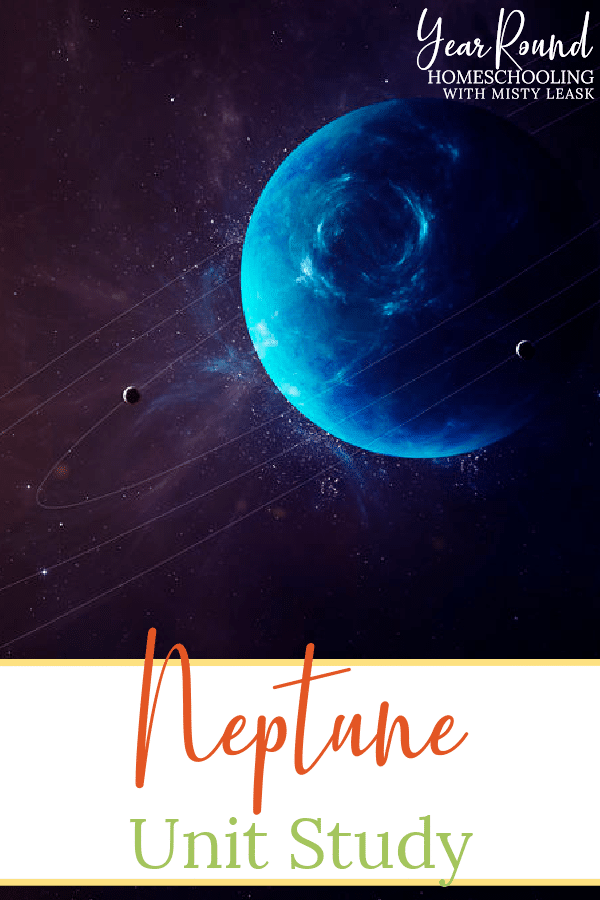The farthest planet from the Sun is the coldest, right? Wrong. Teach your kids all about the 8th planet in the Solar System with this Neptune Unit Study.

Science class in our homeschool involved a lot of outdoor time. We hiked and learned about trees, plants, flowers and animals. At night we laid out under the stars and studied the night sky.
We took pictures and drew sketches of everything we’d seen. Afterward, my kids would complete their studies by researching on their own.
The Solar System is by far one of my kids’ favorite science studies from their elementary school years. They made a model that hung from their bedroom ceiling for years.
Making science a subject that your kids can experience is key to them enjoying and remembering it.
Neptune Unit Study
Neptune
The only planet that is not visible to the naked eye is Neptune. It is also the first planet that was actually predicted by mathematics.
With it being the farthest planet from the Sun, you would think it would be the coldest, but it isn’t. However, it does make for crazy seasons. Each of the 4 seasons lasts 40 years on Neptune!
Neptune is the windiest planet in our Solar System with winds reaching up to 1,200 miles per hour!
- Name
The planet Neptune is named after the Roman god of the sea.
- Size
Neptune is the 4th largest planet in our solar system.
-
- Radius
The radius of Neptune is 15,299.4 miles, making about 4 times wider than our home planet, Earth! To find the radius of a planet you need the distance from the center to the edge of the planet. You can figure out the radius if you know the circumference, diameter or area using these formulas.
-
- Diameter
In order to find the diameter of Neptune, you’ll need to take the radius and multiply it times 2. In doing so, you’ll find that Neptune’s diameter is 30,598.8 miles.
-
- Mass
At 1.02 x 1026, Neptune is 17.1 times more massive than Earth. Be sure not to confuse mass with weight. The difference between weight and mass is that weight is determined by the pull of gravity on an object.
-
- Volume
The volume of Neptune is 15,000,714,125,712 miles3. The measure of volume determines how much space a three-dimensional object such as a planet occupies. To find Neptune’s volume on your own you’ll need this mathematical formula, V = 4/3 pi x r^3, and the radius of the planet.
-
- Surface area
Neptune has a surface area of 2,941,431,558 square miles. The find the surface area requires you to determine what number of square units will exactly cover the surface of a sphere. You’ll need this formula to determine Saturn’s surface area, (or any sphere) on your own.
-
- Density
The density of Neptune is 1.64 g/cm³. You can convert the density of Uranus to lbs/gallons using this conversion tool.
- Rings
Neptune has two sets of rings; 5 main rings and 4 ring arcs, for a total of 9.
- Moons
There are 14 known moons surrounding Neptune. The largest being, Triton, which is the only moon to circles its planet in the opposite direction of its rotation.
- Location in the Solar System
Neptune is the eighth and most distant planet from the sun.
- Distance from the sun
Since planets are always moving, how far they are from the sun changes. However, on average Neptune is 2.8 billion miles away from the sun.
- Light time from the sun
It takes 4 hours for light from the sun to reach Neptune.
- Layers
Like Uranus, Neptune is an ice giant and is made up of “icy” materials including; water, methane and ammonia. It also has a small, rocky core which is about the same mass size of Earth.
- Temperature
While Neptune is the farthest planet from the Sun, it isn’t the coldest. The average surface temperature of Neptune is -353 degrees Fahrenheit.
- Speed
The planet Neptune travels 12,158 miles per hour as it makes its way around the sun. That means in one 24 hour day on Earth, Neptune travels 291,792 miles!
- Orbit
It takes approximately 165 years on Earth for Neptune to complete one trip around the sun. 2011 is the first time Neptune has passed by Earth since the planet was discovered!
- Axis Rotation
Neptune completes a full axis rotation in 16 hours, meaning one day on Neptune is only 16 hours long.
- Atmosphere
Neptune’s atmosphere is made up of hydrogen, helium and methane. Like Uranus, Neptune gets its blue color from the presence of methane in its atmosphere. However, it is a much brighter blue than Uranus, so there must be something else in the atmosphere.
Please note, that some of the resources below may include evolutionary information. I encourage you to have a conversation with your children or preview these resources prior to assigning them as part of your homeschool studies.
Articles
Literature
 Neptune: Planets in Our Sol...Shop on Amazon
Neptune: Planets in Our Sol...Shop on Amazon Neptune: The Planet, Rings,...Shop on Amazon
Neptune: The Planet, Rings,...Shop on Amazon Atlas of NeptuneShop on Amazon
Atlas of NeptuneShop on Amazon Neptune (My Early Library: ...Shop on Amazon
Neptune (My Early Library: ...Shop on Amazon NeptuneShop on Amazon
NeptuneShop on Amazon Neptune (True Books)Shop on Amazon
Neptune (True Books)Shop on Amazon Neptune - Space Books for K...Shop on Amazon
Neptune - Space Books for K...Shop on Amazon Are We There Yet? All About...Shop on Amazon
Are We There Yet? All About...Shop on Amazon Neptune (Planets)Shop on Amazon
Neptune (Planets)Shop on Amazon Neptune (Planets in Our Sol...Shop on Amazon
Neptune (Planets in Our Sol...Shop on Amazon Neptune (Scholastic News No...Shop on Amazon
Neptune (Scholastic News No...Shop on Amazon Neptune: The Stormy Planet ...Shop on Amazon
Neptune: The Stormy Planet ...Shop on Amazon The Secrets of Neptune (Pla...Shop on Amazon
The Secrets of Neptune (Pla...Shop on Amazon Neptune Is Too Far Away | S...Shop on Amazon
Neptune Is Too Far Away | S...Shop on Amazon
Videos
Art
Colored Pencil Neptune Drawing
Printables
What did your kids enjoy learning the most through your Neptune unit study?

